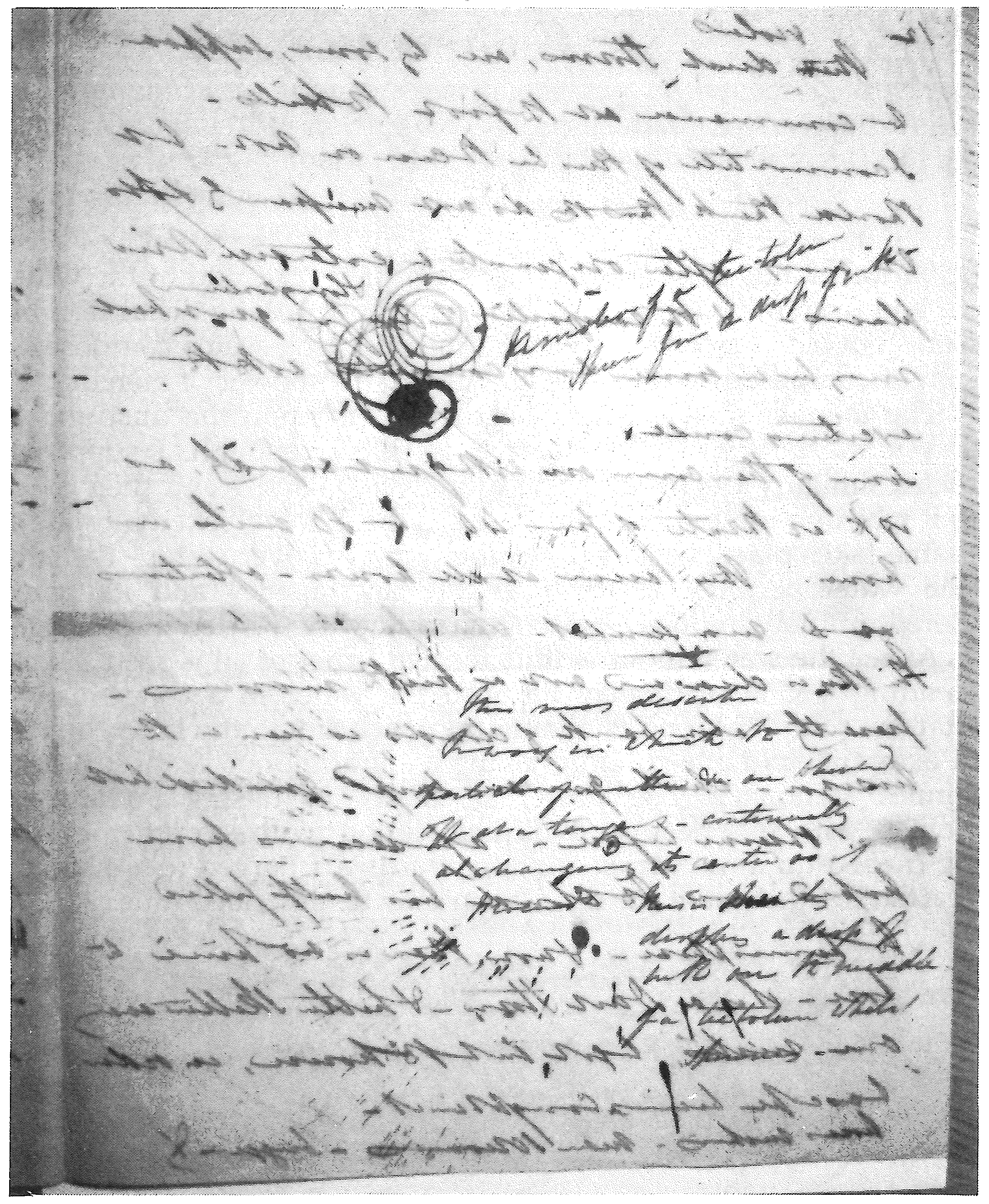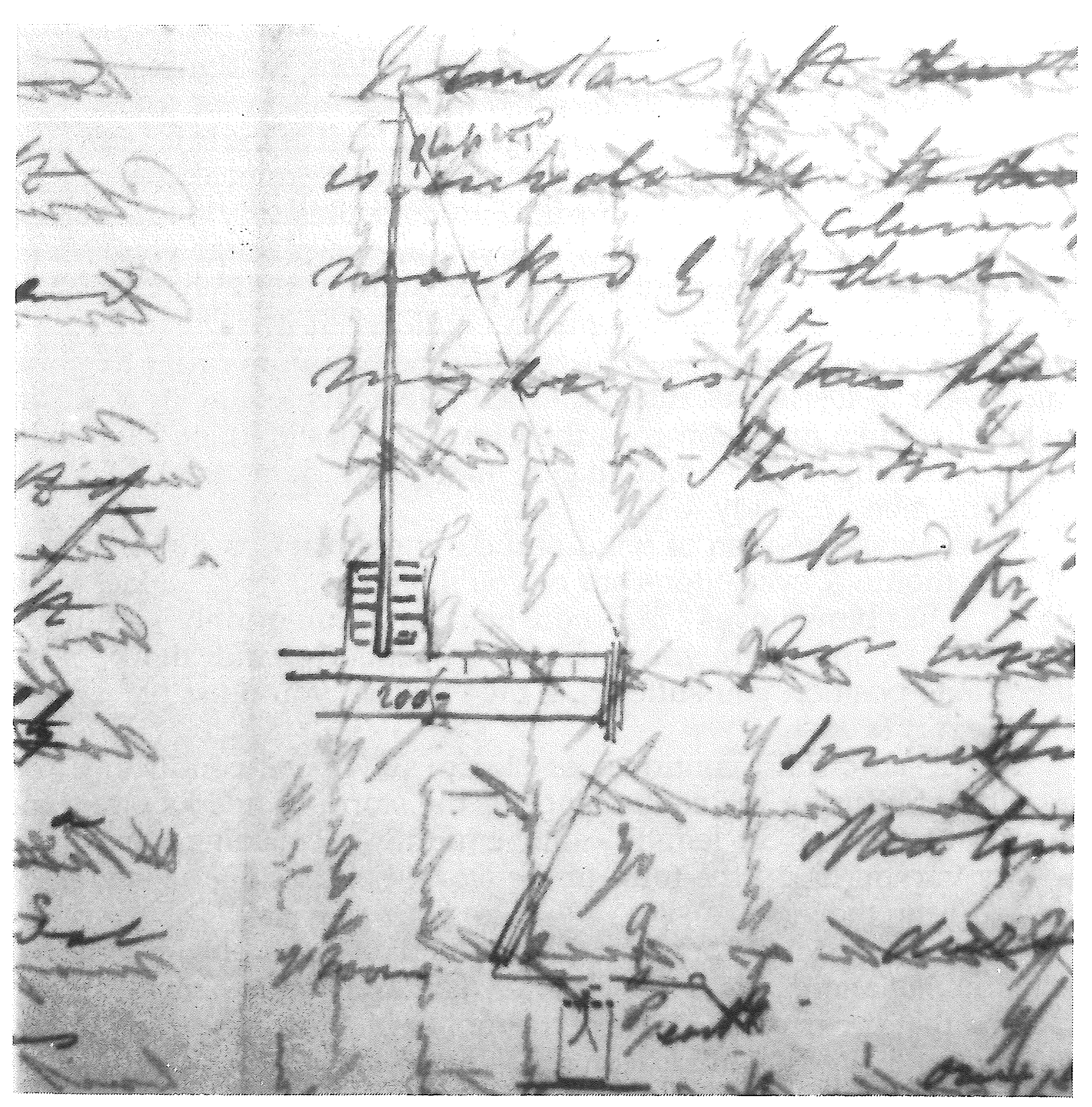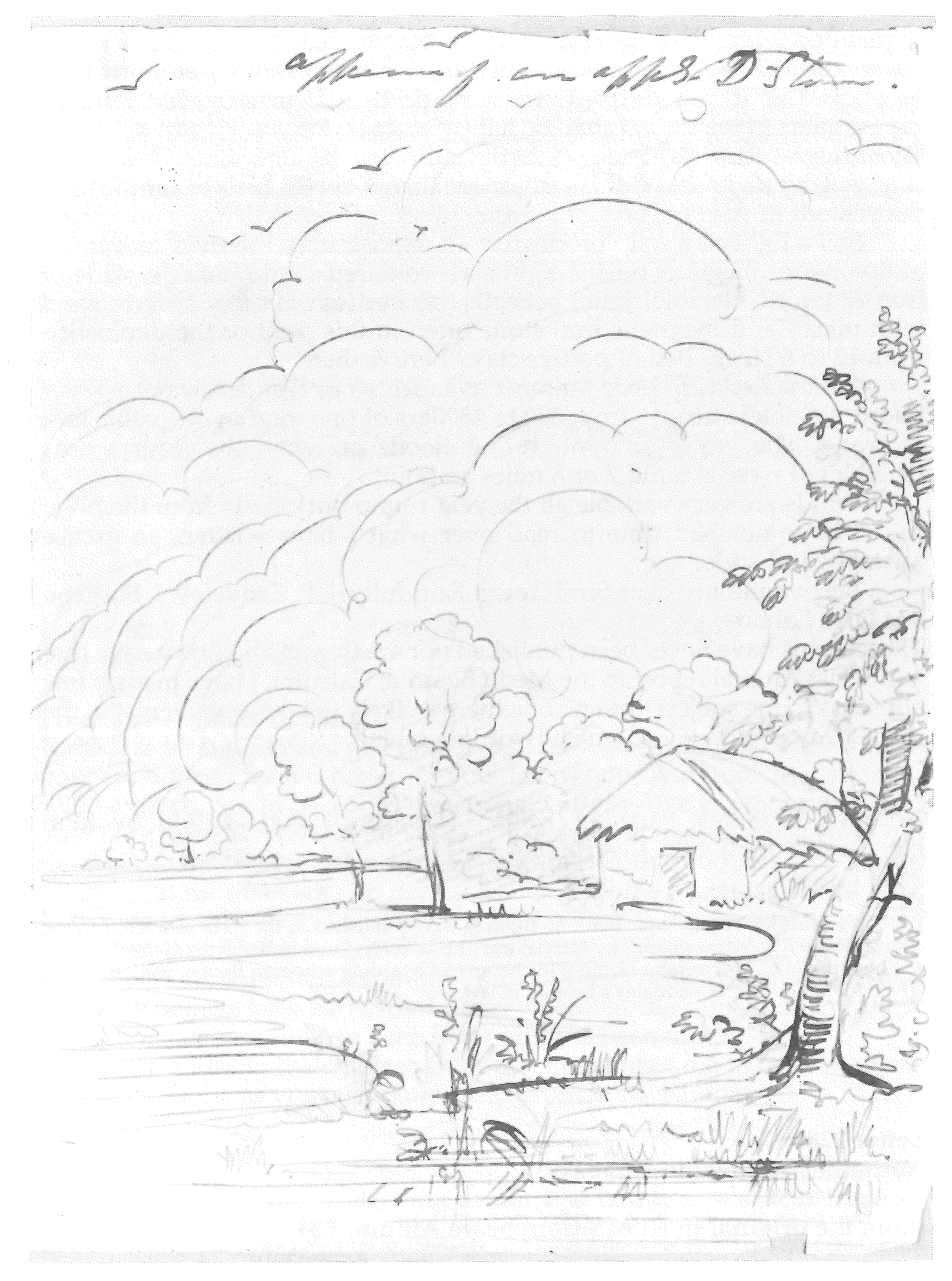Paul Frederick Henry Baddeley to Faraday 18 April 1850
Professor Farriday London.
Lahore 18h Apr 1850.
My dear Sir,
I have only an hour or two to spare, before the Indian mail leaves this, to give you a few notes regarding Dust storms, which are very prevalent in this part of India during the dry months of April, May & June - that is before the setting in of the rainy season.
My observations on this subject have extended as far back as the hot weather of 1847 when I first came to Lahore and the result is as follows. Dust storms are caused by spiral columns of the Electric fluid passing from the atmosphere to the earth - they have an onward motion - a revolving motion, like revolving storms at sea - and a peculiar spiral motion from above downwards - like a corkscrew. It seems probable that in an extensive dust Storm there are many of these Columns, moving on together, in the same direction - and during the continuance of the storm, many sudden gusts take place at intervals during which time, the Electric tension is at its maximum. These storms hereabouts, mostly commence from the N.W. or W. and in the course of an hour more or less they have nearly completed the circle, & have passed onwards.
Precisely the same phenomena, in kind is observable in all kinds of D.St. from the sturdy one of a few inches in diameter to some that extend for 50 miles & upwards; the phenomena is identical.
And it is a curious fact that some of the Smaller Dust storms, occasionally seen in extensive & arid plains - both in the Country & in Affghanistan above the Bolon Pass - called in familiar language “Devils” - are either stationary, for a long time, that is upwards of an hour - or nearly so - & during the whole of this time the dust & minute bodies on the ground are kept whirling about into the air. In other cases these small dust storms - are seen slowly advancing & when numerous usually proceed in the same direction - Birds - Kites & Vultures are often seen soaring first high up above these spots; apparently following the direction of the column, as if enjoying it.
My idea is that the Phenomena connected with Dust storms are identical with those present in water spouts & white Squalls at sea - and revolving storms - & tornadoes of all kinds - and that they originate from the same Cause - viz moving columns of electricity.
In 1847 when at Lahore - being desirous of ascertaining [word illegible] the nature of Dust Storms I projected into the air an insulated copper wire on a Bamboo - on the top of my house - & brought the wire into my room & connected it with a gold leaf electrometer and a detached wire communicating with the Earth - a day or two after, during the passage of a small dust storm, I had the pleasure of observing the electric fluid passing in vivid sparks from [one] wire to another - and of course strongly affecting the electrometer.
The thing was now explained - and since then I have by the same means - obsd at least 60 dust storms of various sizes - all presenting the same phenomena in kind.
I have commonly obsd that towards the close of a storm of this kind, a fall of rain suddenly takes place and instantly the stream of electricity ceases or is much diminished - and when it continues, it seems only on occasions when the storm is severe - and continues for some time after it. The Barometer steadily rises - thro’ out - in this pt of the world the fluctuations of the Barometer column is very slight - seldom more than 2 or 3 tenths of an inch at a time.
The average height at Lahore is 1.180 corrected for temperature - indicating I suppose above 1150 feet above the level of the sea taking 30 Inch as the standard.
A large Dust storm is usually preceded by certain peculiarities in the dew point and the manner in which the particles of Dew is deposited on the Bulb of a thermometer. My mode of taking the Dew point is to plunge a Common thermometer in a little Ice, let it run down 20 or 30˚ take it out shake dry - hold it up to the light and observe the bright spot, & continue to shake off the dew so long as it is deposited and dulls the bulb at the instant it clears off mark the temp. This I have compared frequently with Daniell’s Hygm cooled by means of Chloroform - & find them both correspond with the greatest accuracy.
This is a digression - but I have no time to arrange & must therefore put down my remarks as they occur to me.
The dew point varies very much but is usually many degrees below the temp of air 20 to 50˚ or more.
It also varies according to the time of year during November last mean te[m]p of D.P. was about 47˚. That of the air about 71˚.
In January 1850 D.P. 43˚ in the air 61˚ & the mean temp of self Reg then 45.4.
In February 1850 mean of D.P. 48˚ and air 64˚.5.
April 1850 mean temp of D.P. so far is about 60˚ & the air 84˚.
The sparks or the stream of electricity as it is seen passing from one wire to the other, is in some cases, and during high tension doubled or trebled thus and is never straight but invariably more or less crooked.

Various kinds of sparks as seen - at times - one end of the wire has a star and from the wire when held just beyond striking distance, a brush is seen - curved which when viewed th[r]o’ a lens seems composed of a stream or curved brush of bright globules like a shower of mercury.
The manner in which the Electricity acts upon the dust and light bodies it meets with in its passage, is simple enough. I suppose the particles similarly electrified and mutually repulsive - and then together with it whirling motion communicated to them are whisked into the air, - the same takes place, when the electricity moves over water - the surface of the water becomes exposed to the Elec. agency and its particles rendered mutually repulsive, are in the same way whirled into the air.
At sea the water spout is thus formed - first of all is seen the cloud descending - & beneath may be obsd the water in a cone misty and aggitated - soon the cloud is seen to approach & join the latter, involving both extremities in one column having a spiral motion & on it moves or continues stationary. The power of Electy in raising bodies, when combined with this peculiar whirling motion, will account for fish &c being carried up in its vortex and afterwards discharged to a distance on the earth. The motion of the dust storm may be described thus

Or by spinning a tee-totum, on a drop of Ink and the way in which bodies are projected may be in like manner described by letting fall a drop of ink on the centre of a teetotum while spinning - in this case the particles of ink are thrown off at tangents ever varying, as the centre moves - and perhaps it will be found that when these kind of storms pass thro forrests - trees uprooted are distributed something in this manner.

The violent dust storms, are by some, supposed to commence at the foot [of] the hills. I cannot tell if this be the case or not - but should think that they do not necessarily do so since many often originate in extensive Arid plains - & the rarefaction of air from great & long continued heat may be in some way connected with the exciting cause.
Some of them come on with great rapidity, as if at the rate of from 40 to 80 miles an hour. They occur at all hours - oftentimes near sunset.
The sky is clear and not a breath moving - presently a low bank of clouds is seen on the horizon - which you are surp[rise]d you did not observe before - a few seconds have passed and the cloud has half filled the hemisphere - & now there is no time to lose - it is a Dust Storm - & helter skelter every one rushes, to get into the house, in order to escape being caught in it - horses rushing - men screaming - buggies & tearing allowing [sic] like mad - on rolls the Cloud - majestic - cloud involving cloud - infolding itself - and like a mass of dark rocky mountain - imperilling men - & ready to fall.
Now comes the rush of wind and darkness black as night, follows, shut your mouth & eyes - don’t stir or you’ll hit a wall, or get a kick - then wait, till it has blown over - may be 2 hours or more or only 1/2 an hour if more lucky - and then you must wait patiently, and think of the disagreeable position you suffered & then a wash you must have, to get rid of the dirt & dust.
The Electric fluid continues to stream down the conducting wire unremittingly during the continuance of the storm. It sparks oftentimes upwards of an inch in length - and emitting a crackling sound - its intensity varying upon the force of the storm - and as before said, more intense during the gusts.
Many dust storms occur at Lahore and in the Punjaub generally during the hot and dry months - as many as 7 and 9 in one month.
One that occurred last year in the month of August, seemed to have come from the direction of Lica, on the Indus to the West & by S. of Lahore - and seemed to have a N-Ely direction. An officer travelling and at the distance of 20 miles or so from Lica, was suddenly caught in it - his tent was blown away & he himself knocked down - & nearly suffocated by the sand. He stated to me that he was informed by one resident at Lica, that so great was its force at the latter place, as to crack the walls of a substantial brick dwelling in which the above Officer had lately resided & uprooted some trees about.
The instant the insulated wire is involved in the electric current marked by the column of dust - down streams the electricity my wire is thus placed.

I have sometimes attempted to test the kind of Elect. & find that it is not invariably in the same state - sometimes appears + on other times - & changing during the storm.
One day I caused the current to pass thro’ a solution of Cyanide of Silver - so as to affect a small piece of copper which was rapidly covered with a coating of Silver - which upon drying peeled off - in this case the Cyanide of Silver was pure - without any salt - but in subsequent attempts to silver a wire in this way, I have not succeeded only a very slight deposit taking place which was not increased by long exposure to the influence but in all the cases I tried subsequently to the one first alluded to, the oxide of silver was diss[olve]d in Cyanide of Potassium.
In the course of time bright minute crystals were formed - transparent & colourless - on a copper coin.
Not knowing anything about the science of electricity - I am unable to institute experiments, such as might suggest itself who was well acquainted with the subject but it is possible you may see in the few crude observations I have now made something on which some useful fact may be elicited & if you think it worth while to inform me what kind of experiments to institute, I shall be happy to do so for you if I can & let you know the result.
A very dry climate this - not more than 12 or 14 Inch of rain falls in the year.
Soil a light clay soil - productive - a deposit from the river composed of fine [word illegible] buff or light slate coloured sand much peroxide of Iron & [word illegible] lime, beneath this stratum is often Quartz sand with mica - and magnetic Iron stone often in this sand or the dep[osi]t - from 12 to 60 feet - bed of potters clay - here & there.
Rain water very pure - almost as much so as distilled water - River [word illegible] stream - from 300 to 1800grs of fine mud in one cubic foot of water. The larger amount during floods or when the [four words illegible] of river is rapid 7 or 8 miles an hour.
Winds are very variable all the year round but chiefly from the NW.

I have not had time to read over what I have written, so excuse mistakes and style.
Believe me my dear Sir | Yours Faithfully | P. Baddeley | Surgeon Ast Dr | Lahore
These obsns have never been published nor are they at all known save that in my last Annual report to the Medl. Board at Calcutta, I have made a few allusions to the subject - but no one there is likely to take any interest in the matter, nor consider it so much [word illegible]1.
Address: Professor Farriday, F.R.S. | London | For[warde]d by John Fleming2 Esq | Bootle, Liverpool.
Bibliography
BADDELEY, Paul Frederick Henry (1850a): “On the Dust-storms of India”, Phil. Mag., 37: 155-8.
BADDELEY, Paul Frederick Henry (1850b): “On the Dust-storms of India”, J. Asiatic Soc. Bengal, 19: 390-4.
Please cite as “Faraday2281,” in Ɛpsilon: The Michael Faraday Collection accessed on 25 April 2024, https://epsilon.ac.uk/view/faraday/letters/Faraday2281